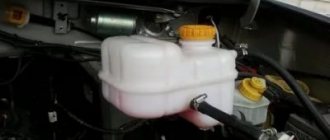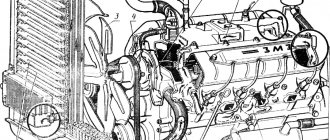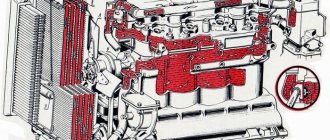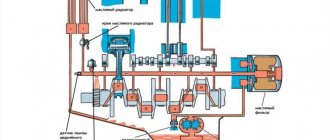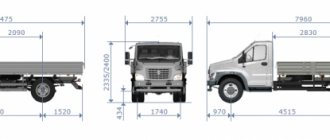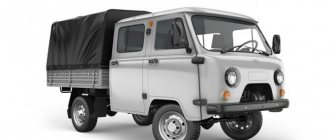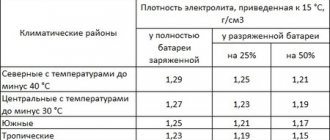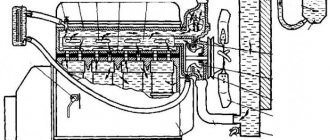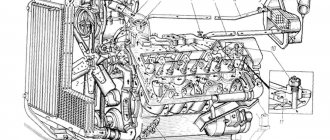The YaMZ-650 6-cylinder diesel power unit is a Russified version of the famous French DCi11 engine, created by Renault Trucks. Russian designers acquired a license for their own assembly of such engines back in 2006, not even suspecting that their creation would become so widespread not only in the Russian Federation, but also in other CIS countries.
By the way: I bought the license of GAZ Group of Companies. The YaMZ 650 engine came into her field of vision due to its excellent technical characteristics and long service life, as well as good maintainability.
The power unit became widespread thanks to heavy trucks from Renault, but it was installed not only on these vehicles. What other vehicles are equipped with this engine, what its features and advantages are, will be discussed in our material today.
Origin of the engine
The production of engines, which became the topic of our conversation, is established at the Yaroslavl Motor Plant. The manufacturer manufactures products in-house, using French equipment and a production line that was specially purchased in France. Thus, we are talking about our own production, and not about assembling engines from parts supplied from abroad.
YaMZ lubrication system valves
The design of the pressure relief valve of the pressure section of the oil pump, the safety valve of the radiator section and the drain valve of the lubrication system is basically the same, and the relief and drain valves differ from each other only in the springs, which have different characteristics. It should be borne in mind that the pressure relief and drain valves, having the same installation dimensions, are adjusted to different opening pressures, so swapping them or replacing one valve with another is strictly prohibited. The safety valve of the radiator section is distinguished by the external thread of the body and therefore cannot be installed in another hole.
Lubrication system valves
— plunger type, mounted in a cylindrical tubular body. On the outside, a cylindrical thread is cut on one of the ends of the housing, which serves to install the valve into the corresponding threaded hole in the pump housing or cylinder block. To tighten the threaded connection, there are turnkey flats on the body. The inner surface of the valve body is machined and has two stages. A stage of smaller diameter serves as a valve guide, and the second stage forms a stop on which the valve sits with its shoulder. A rectangular groove is made along the generatrix of the guide part of the housing bore, along which part of the oil flows into the plane of the spring when the valve opens. This device allows you to dampen valve vibrations during operation. In the middle part of the housing there are four radial drillings through which, when the valve is open, excess oil is drained into the engine crankcase. At the free end of the housing there are two diametrically located holes into which an adjustable cotter pin is installed.
Valve
has a cylindrical shape with a collar. The outer guide surface of the valve is machined. On the shoulder side of the valve there is a blind hole into which the spring fits. The other end of the spring rests against a special cap, the design of which provides for limiting the maximum movement of the valve. At the outer end of the cap there is a diametrically located rectangular groove through which the housing adjustable cotter pin passes. This prevents the cap from turning during valve operation and protects the cotter pin from chafing.
The tightening of the valve spring is regulated by special shims installed between the cap and the spring. The number of washers on each valve should be no more than 4.
Source
Features of production and design
The motors are assembled on a floor conveyor consisting of two successive threads, which are divided into ¾ and ¼, respectively. Assembly is carried out in stages, the process is fully automated, the parts are connected and moved between stations on special trolleys, the load capacity of which increases as the assembly process of the unit comes to an end.
The first post is the place where the robotic installation performs cylinder liners, then the engine is equipped with pistons and parts that make up the crank mechanism. The next step is installing the crankshaft, after which automatic testing for cranking begins.
Upon completion of this stage, the distributor gears, cover and crater, and a number of other parts are installed, and then the YaMZ-650 fuel pump is installed.
Further steps are the gradual equipping of the future engine with such important parts as YaMZ-650 valves, injectors, rods and rocker arms, and valve covers. Once that's done, the final stage of production begins when the powertrain sump is installed.
After the future motor successfully passes the ¾-conveyor, the following testing is carried out - the product is checked for the tightness of the cavities using an air flow supplied under enormous pressure. The engine then moves to the last part of the production line, where it is equipped with attachments, manifolds (intake and exhaust), wiring and other electrical components, as well as a turbine.
Important
In contrast to the French analogue, the Russian product is adapted to local realities - the intake manifold is equipped with spirals for heating cold air, ensuring prompt engine starting at sub-zero temperatures.
The next step is the so-called control crimping, which is necessary to ensure proper assembly quality. Maximum attention is paid to the tightness of connections and the cooling system.
Before being sent to the client, the motors are sent to a special stand, where they are hot run-in. Thanks to such strict control at every stage, Russian-made motors fully comply with international standards.
The principle of operation of the fuel system
The fuel YaMZ 650 operates in a standard way. Fuel from the main tank passes through the coarse filter and the electronic control cooler. Then it is sucked inside using a pump that pumps fuel under pressure up to 700-800 kPa, and then enters a fine filter with a high level of purification. This type of system is much more susceptible to contamination compared to analogues equipped with a standard plunger-type fuel pump.
The fuel then passes into a high-pressure pump equipped with a pair of sections, each of which is powered by a metering element supplemented by an electric valve. From the pump, the fuel liquid passes into the main fuel accumulator under pressure, after which it is supplied to the injectors through individual fuel wires. The injectors are capable of supplying fuel liquid to the combustion chamber; the duration of one injection can be determined by the frequency of the electrical pulse from the unit that will control the engine.
The fuel injection process is carried out in three stages:
- Pilot injection within 1-3% with early angles to advance injection is carried out in order to reduce the noise effect of the engine.
- Main injection within 94-96%.
- Auxiliary injection within 1-5% in order to reduce the opacity of exhaust gases.
The fuel balance during injection can be determined by the operating mode of the engine. Electric valves help regulate the fuel pressure that enters the pump space above the plunger. In the fitting parts of the frame there are hydraulic limiters for the consumption of fuel fluid. They are capable of blocking the delivery of the fuel element to all injectors if the specified injection duration is exceeded, for example, when an injector suddenly becomes clogged. The operation of the limiting element will be restored to standard mode after the problems with the nozzle are eliminated.
Sensors on the engine are capable of transmitting data to the electronic unit for control, due to which the system operates. The blocks use this data to control injection and send signals about the performance of other systems to the instrument panel, as well as control the execution mechanisms responsible for the operation of the motor element. The information comes from the pressure sensor inside the rail, the phase element, temperature and air pressure, rotation speed, and oil pressure.
Where is YaMZ-650 used?
The key consumer of engines was the Minsk Automobile Plant. YaMZ-650 is installed on 2-axle MA3-544OA9 tractors operated with semi-trailers, on dump trucks, trucks and chassis of this manufacturer weighing up to 52 tons. The engines also performed well on road trains whose total weight does not exceed 65 tons.
The installation is also used on those manufactured by Minsk (on tractors, trucks, dump trucks and chassis with a total weight of up to 41 tons). Such engines are also installed on road trains whose weight does not exceed 54 tons.
A major customer of YaMZ-650 is MZKT from Belarus and operating in the Moscow region. According to experts, it is possible to install 6-cylinder engines from the Yaroslavl plant on combine harvesters, heavy tractors, and also on industrial special equipment.
«4»>
Oils for engines without turbocharging (YAMZ-1-97 oil group)
YaMZ-236M2, YaMZ-238M2
| Oil brand | Standard number | Manufacturer |
| M-10-G2(k) M-8-G2(k) | GOST 8581-78 | LLC LUKoil-Permnefteorgsintez, OJSC Norsi, OJSC Ryazan Refinery, OJSC Slavneft-Yaroslavnefteorgsintez, OJSC Yaroslavl Refinery named after. Mendeleev", LLC "LUKoil-Volgogradneftepererabotka", OJSC "Angarsk Petrochemical LUKoil-Permnefteorgsintez" |
| M-6z/10-V | GOST 10541-78 | OJSC Norsi, OJSC UfaNeftekhim |
| M-6z/12-G | TU 0253-011-00151742-95 | JSC "Kremenchug Oil Refinery" |
| Slavol M-3042U (M-10-G2u) Slavol M-2042U (M-8-G2u) | TU U 13932946.015-96 | NPP "Additives" |
| Lukoil Standard SAE 10W-30, AR SF/CC | TU 0253-072-00148636-95 amended. 1-8 | LLC "LUKoil-Permnefteorgsintez" |
Note
: For engines without turbocharging, it is allowed to use oils of the YaMZ-2-97 - YaMZ-5-06 groups with twice the changeover period.
Specifications
The characteristics of the power plant, which became the subject of our interest, have remained virtually unchanged since its invention. The only innovation is the appearance of turbocharging, an exhaust gas exhaust system and a power supply system. More detailed technical characteristics of the motor can be found in the table below:
| Characteristic name | Meaning |
| Power, l. With. at rpm | 311 - 412 at 2000 |
| Volume, cubic cm | 11120 |
| Number of cylinders | 6 |
| Number of valves | 24 |
| Rotation torque, Nm at rpm | 1870 at 1300 |
| Compression ratio | 16,4 : 1 |
| Cylinder diameter, mm | 123 |
| Piston stroke, mm | 156 |
| Cylinder arrangement | Row |
| Supply of combustible mixture | Direct injection |
| Exhaust gas standard | Euro 3 |
| Cooling | Liquid |
Oils for forced turbocharged engines (Oil group YaMZ-2-97 ~ YaMZ-3-02)
YaMZ-236B, YaMZ-238D, YaMZ-850.10
| Oil brand | Standard number | Manufacturer |
| M-10-D2(m) M-8-D2(m) | GOST 8581-78 | LLC LUKoil-Permnefteorgsintez, OJSC Slavneft-Yaroslavnefteorgsintez, JSC Azmol, Berdyansk OJSC Angarsk Petrochemical Ryazan Refinery, LLC LUKoil-Volgogradneftepererabotka |
| Consol M-10-D2(m) Consol M-8-D2(m) | GOST 8581-78 | VIAL OIL LLC, Moscow |
| Omskoil-Turbo 2 (M-10-D2(m)) | TU 38.301-19-110-97 amended. 1-4 | OJSC Omsk Oil Refinery |
| Sam-Oil-4126 M-10-D2(m) | TU 38.301-13-008-97 | OJSC "Novokuibyshevsky Oil Refinery" |
| Sam-Oil-4127 M-6z/14-D(m) | TU 38.301-13-008-97 | OJSC "Novokuibyshevsky Oil Refinery" |
| LUKoil-Super (SAE 15W-40, API CF-4/SG) M-5z/14-E | TU 0253-075-00148636-99 amended. 1 | LLC "NORSI", Kstovo |
| LUKoil-Super (SAE 15W-40, API CD/SF) M-5z/14D(m) | TU 0253-004-00148599-00 as amended. 1 | LLC "LUKoil-Volgogradneftepererabotka" |
| M-16-DR | TU 38.401.642-87 | OJSC Rosneft-MOPZ Nefteprodukt |
| Castrol Formula RS Rasing Syntec (SAE 20W-60, API SH/CF) | — | |
| Titan GT (SAE 20W-50, API SG/CD) | — | |
| Titan Supersyn SL (SAE 5W-50, API CF/SI) | — |
Note
: For turbocharged engines, the use of oils of the YaMZ-4-02, YaMZ-5-06 groups is allowed.
Advantages and disadvantages
No matter how strange it may sound, in the process of preparing this material we were not able to find any shortcomings of these motors. Owners of vehicles with such power units installed under their hoods are unanimous in the opinion that the engines from the Yaroslavl plant are fully adapted to domestic conditions; they easily cover 300, or even more, thousand kilometers.
Repairing the YaMZ-650 also does not cause any problems, because there are enough components on the market. The power plants are high-torque, they easily cope with their functions, ensuring the free movement of heavy loaded equipment over long distances in any operating conditions.
YaMZ 7511.10
| Oil brand | Standard number | Manufacturer |
| UTEC Superdiesel (SAE 10W-40, API CF-4/SG) M-4z/14-E UTEC Superdiesel (SAE 15W-40, API CF-4/SG) M-5z/14-E Oil brand | TU 0253-283-05742746-95 amended. 1Standard number | OJSC "Angarsk Petrochemical LUKoil-Permnefteorgsintez" Manufacturer |
| Rolls Turbo (SAE 15W-40, API CF-4/SF) M-5z/14-E Oil brand | TU 38.301-41-185-99 Standard number | OJSC "Ryazan Oil Refinery" Manufacturer |
| LUKOIL-avant-garde (SAE 15W-40, API СG-4/SJ) М-5з/14-Э Oil brand | TU 0253-102-00148636-00 as amended. 1…4 Standard number | LLC "LUKoil-Permnefteorgsintez" Manufacturer |
| Spectrol Champion (SAE 15W-40, API CF-4/SG) M-5z/14-E Oil brand | TU 0253-15-06913380-98 Standard number | CJSC PG "Spektr-Avto" Moscow Manufacturer |
| Essolube XT-4 (SAE 15W-40, API CF-4/CF) Oil brand | -Standard number | Exxon Mobil Company Manufacturer |
| Consol Titan Transit (SAE 15W-40, API CF-4/SG) M-5z/14-E Oil brand | TU 0253-007-17280618-2000 Standard number | VIAL OIL LLC, Moscow Manufacturer |
| Shell Rimula D (SAE 10W-30, API CF-4/SG) Oil brand | -Standard number | Shell East Europe Co Manufacturer |
| Shell Rimula D (SAE 15W-40, API CF-4/SG) Oil brand | -Standard number | Shell East Europe Co Manufacturer |
| VNII NP M-5z/16-D2 Oil brand | TU 38.401-58-309-2002 Standard number | OJSC Rosneft MOPZ Nefteprodukt Manufacturer |
| Ravenol Turbo-Plus SHPD (SAE 15W-40, API CI-4/CH-4/CF/SL) Oil brand | -Standard number | Ravensberger Schmierstoffvertrieb GmbH, Germany Manufacturer |
| LUKOIL-Diesel (SAE 10W-40, API CF-4/SG) M-5z/14-E Oil brand | TU 38.601-07-38-2002 Standard number | OJSC LUKoil-Nizhegorodnefteorgsintez Manufacturer |
Note: For YaMZ engines that meet Euro-2 environmental standards, the use of motor oils of the following groups is allowed: a) YaMZ-5-06, b) YaMZ-2-97...YaMZ-3-02 with a change period half as long as for group oils YaMZ-4-02.
Oil pump pressure reducing valve - what is it and what is it for?
A car engine cannot function normally without constant lubrication with engine oil: parts will heat up from excessive friction and quickly become unusable. In order to ensure constant lubrication of all necessary elements, a design such as an oil pump was developed. It is he who is responsible for the supply and distribution of the lubricant.
However, here you need to pay attention to one important point: if the oil flowed freely, solely under the influence of gravity, many remote and hard-to-reach parts would not receive their share of lubrication and would run dry. On the other hand, too much pressure inside the pump would also increase wear on a number of elements. Oil seals and gaskets especially suffer from this, because due to the strong flow pressure they become thinner and begin to leak oil through themselves.
From all of the above, it is easy to conclude that the oil pump needs a special device responsible for maintaining stable pressure inside the system. Based on this feature, all pumps are divided into two categories:
The first type regulates pressure by changing the position of a certain part of the pump. But in the second, this function is performed by a pressure reducing valve. This is what we will talk about in more detail.
Reduction (from lat. reductio return bringing back) - simplification, reduction of the complex to something simpler, more visible, understandable, more accessible for analysis or solution; decrease, weakening of something.
Big Encyclopedic Dictionary
Malfunctions in the operation of the pressure reducing valve
The structure of the pressure reducing valve is quite simple, which ensures its reliability and reduces the likelihood of breakdown. However, sometimes this still happens. Most often this is due to wear and tear of the mechanism, so do not forget to regularly diagnose all components of the car, as well as promptly replace outdated parts.
There are two main types of mechanism failure.
- The valve creates insufficient pressure. Usually the cause of this problem lies in the spring. With prolonged use, it becomes less elastic and stretches. As a result, the valve remains slightly open all the time. Due to this, the pressure decreases, and the oil does not reach some engine components. Sometimes it happens that unprofessional craftsmen install a spring with insufficient elasticity during repairs. This has the same effect.
- Excessive pressure builds up in the valve. As a rule, the cause of this breakdown is the entry of debris into the mechanism or the use of old viscous oil.
How to determine that the pressure relief valve is broken?
It is impossible to determine at first glance that the valve is broken. It is necessary to carefully inspect other elements of the system and exclude the possibility of damage to other parts of the oil pump. In order to understand that there are malfunctions in it, you should look at the dashboard. Most car models have a sensor located there that indicates problems in the system. It is a warning light with a pictogram that lights up at high speeds.
If this happens, you should stop the car immediately, as further movement may lead to permanent engine damage. Turn it off and get out of the car. Next, you will need to take the following steps.
- Wear protective gloves. At the moment, the engine compartment of the car is hot, so you can easily get burned.
- There is no point in checking the oil level if you have just stopped. It will take time before it drains into the crankcase. At this time, you need to inspect the engine: look for fresh oil leaks or damage to the crankcase.
- If the problem is a broken crankcase, you will need to seal it. This can be done using available materials: an ordinary rag, a piece of rubber and even tape.
- Inspect the oil filter. Damage to its gasket can also cause a breakdown.
- If the above items are in order, you should check the oil level. This is done with a special probe with o and “maximum”. Ideally, the oil level should be between them. If there is a lack of lubricant, simply add it.
All further actions are carried out on the valve removed from the pumping system. Examine it carefully. Often the cause of breakdown is clogging of the mechanism. This usually happens to drivers who are too lazy to change the oil. Dirt accumulates on the surface of the valve or spring, which prevents normal operation. If you have recently carried out a major overhaul of your car, then there is a risk that the valve was not properly washed and there are particles of chips and other debris left in it.
For this reason, technicians often recommend replacing valves after major repairs. If you do not want to do this, make sure that the system is not clogged before using the vehicle.
There is an unusual way to check the functionality of this element. Take a small piece of cotton (or other breathable) fabric and place it on the fitting that is parallel to the lid. Now you need to take a sharp breath through the material. If you feel strong resistance, it means that the valve is working as it should: it blocks the air flow and passes it through a special hole. A working mechanism should not be easily blown through.
Table: diagnosis of low pressure in the oil pump, causes and remedy
| Guide to diagnosing hypotension | ||
| Malfunction | Cause | Remedy |
|
|
|
| Low oil pressure throughout the entire engine speed range | There is too little oil in the engine. The oil intake screen is dirty, the oil intake tube is broken | Add oil to the engine. Remove the oil sump, clean the mesh, if necessary, replace the tube. |
| Worn oil pump | Remove, check, replace if necessary | |
| Engine bearing wear | Repair the engine | |
